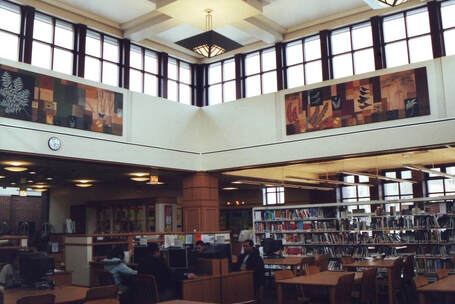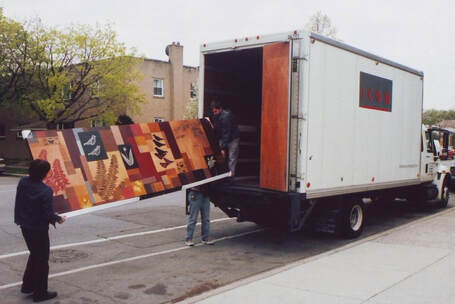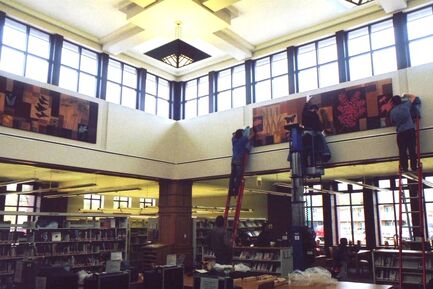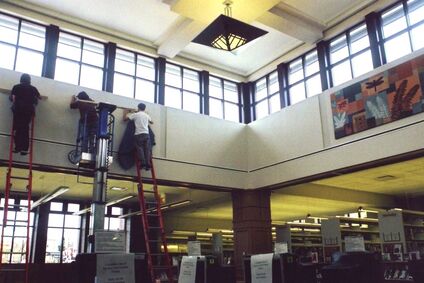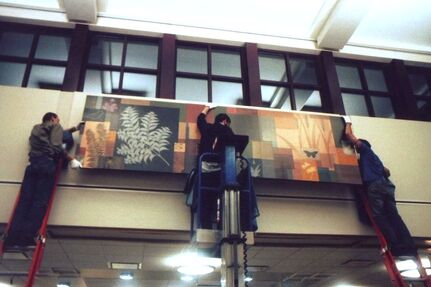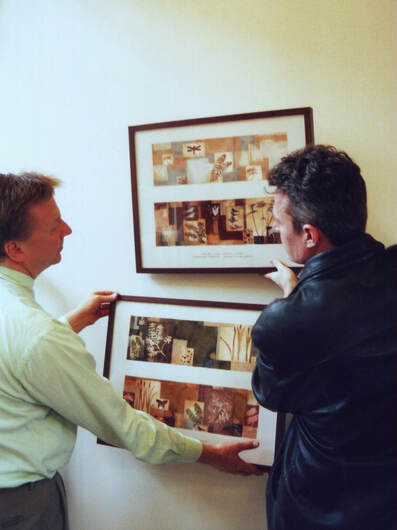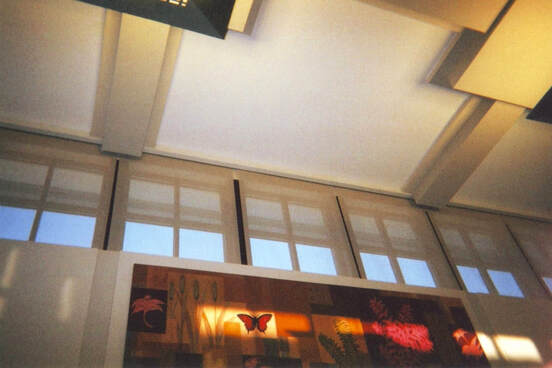Selected Projects
Promised Treasure
City of Chicago Public Art Collection commission
Chicago Public Library, Budlong Woods Branch, 2005
Hand-painted papers laid on four wood panels, 4 x 13 feet each
|
In 2004, I was invited to create an artwork proposal for the Reading Room area of the Budlong Woods branch of the Chicago Public Library. This would be a permanent installation, and forever part of the
City of Chicago’s Public Art Collection. For over 35 years, there has been an ordinance in Chicago stipulating that one percent of a building budget – whether under construction or renovation – be allocated to the creation and installation of art work for the space. This was my second opportunity as a “finalist” in the review process (my first being for a new police station), and a great chance to enhance an environment designed for learning. |
|
During the research for my proposal, I sought information about the history of neighborhood, as well as that of the man for whom the library is named. In an uncanny moment during my study, I even met a regular visitor of the library who knew the area when it was just a landscape of farms and orchards. Without question, the theme of Nature – including species specific to northeastern Illinois – as well as the human settlement and interaction with the territory, came into play. Below is the text for the wall label, excerpted from my research and proposal, including installation views of the 4-painting project (erected in 2005):
|
|
Guide to the Artwork
Wall text for the permanent installation: I experienced sometimes that the most sweet and tender, the most innocent and encouraging society may be found in any natural object, even for the poor misanthrope and most melancholy man. There can be no very black melancholy to him who lives in the midst of nature and has his senses still. – Henry David Thoreau, Walden, 1854 |
|
In the mid-1800’s, Lyman Budlong established a farm and pickle factory in the area now known as Lincoln Square. Not only did the Budlong family business exert a legacy by attracting many immigrant workers, but Mr. Budlong himself seemed to have a sense of the value of the land, in both developed and preserved states. A newspaper article from the turn of the twentieth century speaks to his conservationist sensibility and lists the wildlife on his property finding sanctuary against encroaching civilization. According to another article, growth and prosperity for the pickle farmer also sustained a diverse cultural community, which thrives today.
|
|
The best possible introduction to this, for me, came during my second visit to the site, when I met a man who is a lifelong resident of Lincoln Square. He evoked for me images of a time when the area was still largely a wilderness: a “prairie,” and full of disparate oak stands. “In the late 1920’s,” he recounted, “we would ride our bicycles on long dirt roads, pick a few apples from the orchards…you know, no one would really notice.” It seems fitting that the Budlong name would grace this center of learning: the family and its original business were the nucleus for an integrated community, with special care to nature and youth education.
|
|
Branch Manager, Tom Stark, with the artist, placing studies for Promised Treasure in the library entrance, 2005.
|
The Budlong story and the family’s part in the evolution of this community, is interesting to me as an exemplary relationship between the natural world and the progress of human needs and development. Even today, with the nation’s third largest metropolis, there is a consciousness towards preservation – Chicago is a burgeoning city, but strives actively towards the recovery of its original oak woodlands and savannahs. (As Chicago Wilderness magazine describes it: “…an ongoing rescue of a vital link in this region’s chain of existence.”) No writer in history better comes to mind regarding this interrelationship than Henry David Thoreau (1817–1862). In his book Walden, Thoreau records his experiment living a simple and contemplative life, summarizing his philosophy, his critiques of society and his observations of nature and human relations. My paintings for the Budlong Woods Branch Library integrate aspects of the natural world, in many cases native to Illinois, with geometric forms and excerpts from Thoreau’s writing. Neither element need be portrayed literally or entirely; rather, a sample of a handwritten manuscript juxtaposed with a silhouette of a local blackbird may suggest an elastic but definite kinship. In Thoreau’s fifth chapter, entitled “Solitude,” he considers the most basic of human emotional and spiritual needs, turning to the wilderness, primarily, and also to imagination for nourishment. The Library environment fosters imagination. Nature is our first source.
|
The Percent for Art Program
In 1978 the Chicago City Council unanimously approved an ordinance stipulating that a percentage of the cost of constructing or renovating municipal buildings be set aside for the commission or purchase of artworks for those buildings. The purpose of this law is to provide the citizens of Chicago with an improved public environment by enhancing city buildings with quality works of art by professional artists. The Department of Cultural Affairs is charged with administering this law in cooperation with other city departments. The result of this cooperation is the Public Art Committee, which overseas the implementation of the Percent for Art Program. Project Advisory Panels are appointed for each site to recommend artists for commissions. These panels bring together architects, arts professionals, community representatives, and city personnel. This creative collaboration has enabled Chicago to build one of the finest collections of contemporary public art in the world.
In 1978 the Chicago City Council unanimously approved an ordinance stipulating that a percentage of the cost of constructing or renovating municipal buildings be set aside for the commission or purchase of artworks for those buildings. The purpose of this law is to provide the citizens of Chicago with an improved public environment by enhancing city buildings with quality works of art by professional artists. The Department of Cultural Affairs is charged with administering this law in cooperation with other city departments. The result of this cooperation is the Public Art Committee, which overseas the implementation of the Percent for Art Program. Project Advisory Panels are appointed for each site to recommend artists for commissions. These panels bring together architects, arts professionals, community representatives, and city personnel. This creative collaboration has enabled Chicago to build one of the finest collections of contemporary public art in the world.
